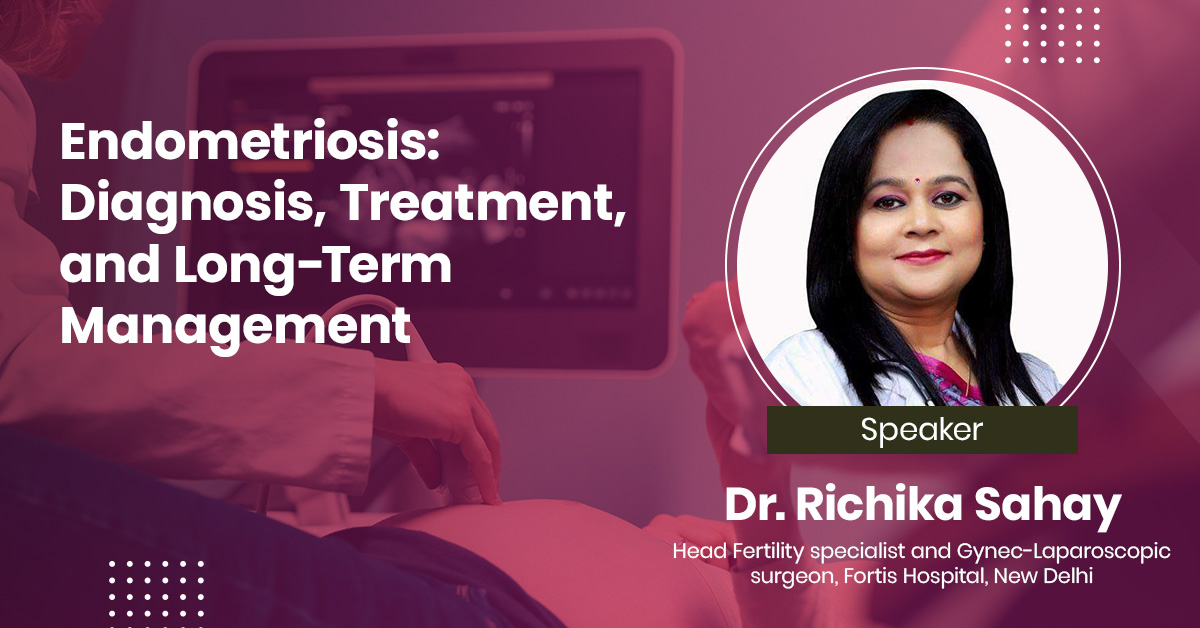- 77.3k views
Endometriosis: Diagnosis, Treatment, and Long-Term Management
Endometriosis is a prevalent illness that can negatively impact quality of life, involve several organ systems, and cause pelvic pain and infertility.There is presently no cure for endometriosis, and its etiology is not entirely understood. While a clear histological diagnosis can be obtained through surgery, the majority of worldwide recommendations currently suggest a nonsurgical diagnosis based on physical examination findings, imaging results, and symptoms in order to minimize therapeutic delays. In order to treat persistent pain resulting from central sensitization and nociplastic pain processes, a multidisciplinary approach may be necessary in addition to hormone suppression, surgery, or a combination of the two.
About the Speaker

Dr. Richika Sahay
Senior Consultant Pediatrician, Mayflower Hospital, Hyderabad
Dr. Richika Sahay Shukla is infertility and IVF Specialist. She is a well qualified and trained professional. Dr. Richika has wide experience and has done extensive training in the field of IVF-ICSI & Gynecological Endoscopy. She has worked with some of the pioneer institutes in India such as AIIMS and Sir Ganga Ram Hospital. She is an expert in doing In- Vitro fertilization(IVF)/ICSI by various protocols and in difficult cases like an elderly patient, postmenopausal, poor ovarian responders. She is an expert in doing Surrogacy, Donor eggs conception. She is an expert in doing difficult oocyte retrieval (adhered ovaries, high ovaries, ovaries with endometriosis). She is an expert in doing difficult Embryo transfers. She has made several patients conceive by doing fertility enhancing surgeries by Laparoscopy and Hysteroscopy (like septal resection, intrauterine adhesiolysis, myomectomy, tubal cannulation). She is well versed with Ultrasound catering to infertility, GYN & OBG.
Upcoming Case Discussions
Impact of Endometriosis on Fertility
Endometriosis, a condition where endometrial-like tissue grows outside the uterus, can significantly impact fertility. It causes inflammation, scarring, and adhesions that may distort pelvic anatomy, block fallopian tubes, and impair ovarian function. Endometriosis is also linked to hormonal imbalances and poor egg quality, reducing the chances of conception. Symptoms like chronic pelvic pain and painful intercourse further complicate fertility. Diagnosis often requires laparoscopy, while management includes pain relief, hormonal therapy, and assisted reproductive techniques like IVF. Early intervention with medical or surgical treatment can improve reproductive outcomes, but severe cases may necessitate advanced fertility treatments for conception.
Hyperlipidemia: From Diagnosis to Treatment
Hyperlipidemia is a condition characterized by elevated levels of lipids, such as cholesterol and triglycerides, in the blood, which can increase the risk of cardiovascular diseases. Diagnosis typically involves blood tests measuring lipid profiles, while treatment focuses on lifestyle changes, such as diet and exercise, alongside medications like statins to manage cholesterol levels and reduce cardiovascular risk. Regular monitoring is essential for effective management and prevention of complications.
Acne: Disorders and Treatment Approaches
Acne is a common dermatological condition caused by clogged pores, excess sebum production, bacterial growth, and inflammation. It can manifest as blackheads, whiteheads, papules, pustules, or cysts, often leading to scarring if untreated. Various factors, including hormonal changes, diet, stress, and genetics, influence its severity. Treatment approaches range from topical and oral medications, such as retinoids, antibiotics, and hormonal therapy, to advanced procedures like chemical peels and laser therapy. A personalized skincare regimen, along with lifestyle modifications, plays a crucial role in managing and preventing acne.
Lung Ultrasound in Acute Respiratory Failure
Lung ultrasound has emerged as a vital, non-invasive tool in the rapid assessment of acute respiratory failure. It provides real-time imaging to differentiate conditions like pneumonia, pulmonary edema, pneumothorax, and pleural effusion with high accuracy. Compared to traditional chest X-rays, lung ultrasound offers superior sensitivity, especially in critically ill patients where bedside evaluation is crucial. Its ability to guide immediate clinical decisions improves patient outcomes and reduces unnecessary radiation exposure. With standardized protocols like the BLUE (Bedside Lung Ultrasound in Emergency) protocol, it enhances diagnostic efficiency in emergency and ICU settings.
Gallstone Disease & Cholecystitis: When to Operate?
iGallstone disease and cholecystitis are common conditions requiring careful evaluation to determine the need for surgery. Symptomatic gallstones causing recurrent pain, nausea, or complications like cholecystitis often necessitate cholecystectomy. Acute cholecystitis, characterized by inflammation, fever, and right upper quadrant pain, typically requires early surgical intervention to prevent complications like perforation or sepsis. In high-risk patients, conservative management with antibiotics and drainage may be considered. Elective surgery is recommended for asymptomatic patients with high-risk factors, such as large gallstones or gallbladder polyps, to prevent future complications.







